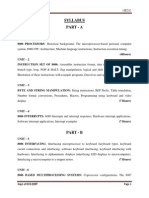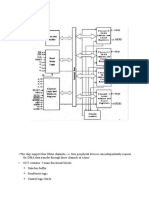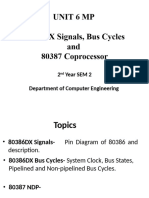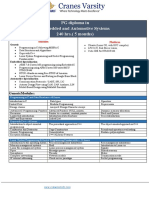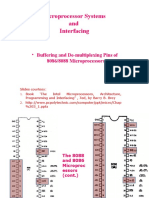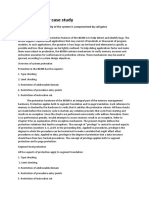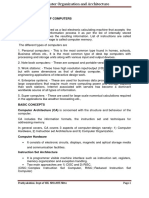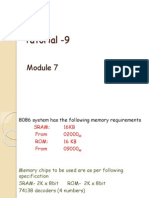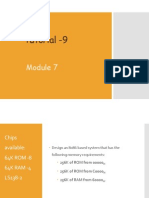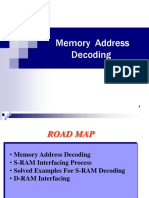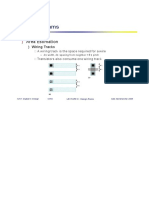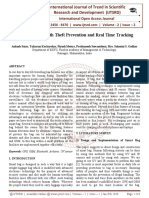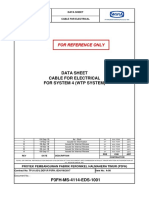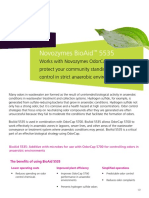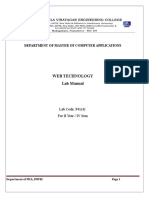CS/ECE/EEE/INSTR F241 MICROPROCESSOR
PROGRAMMING & INTERFACING
MODULE 7: MEMORY INTERFACING
QUESTIONS
ANUPAMA KR
BITS, PILANI KK BIRLA GOA CAMPUS
�Q1.
An 8086 based system has the following memory requirements:
256K of ROM from 00000H
256K of ROM from C0000H
256K of RAM from 60000H.
Chips available:
64K ROM -8, 64K RAM -4, LS138-2. Design the memory Interfacing circuit.
Q2.
For an 80286 processor that has 16 MB of memory of which 4M is ROM and the rest is RAM. Half
of the ROM - mapped to address space starting at 00 00 00H Half to address space starting from
E0 00 00H. The RAM is mapped continuously from address 20 00 00H. Design the memory
Interfacing circuit.
Q3.
For an 8086 based system with the following memory requirements:
SRAM: 16KB from
ROM: 16 KB from
02000H
09000H
The following chips are available
SRAM- 2K x 8bit
74138 decoders (4 numbers)
ROM- 2K x 8bit
Using these decoders and minimum number of logic gates draw the memory interfacing diagram
Q4.
An 8086 system has the following memory requirements:
384K of ROM from 00000H
384K of ROM from A0000H
256K of RAM from 60000H
The following chips are available
32K ROM -24
32K RAM - 8
LS138 -4
Design the memory Interfacing circuit.
�Q5. Design an 80286 based system that has the following memory requirements:
1 M of ROM from 000000H
1 M of ROM from 800000H
1 M of ROM from F00000H
7 M of RAM from 100000H
3 M of RAM from 900000H
Chips available:
512K ROM chip
6 nos.
512K RAM chip
20 nos.
LS138
4 nos.
Show the complete memory mapping and design the memory decoding circuit using only the
chips given. All system bus signals (MEMR, MEMW, IOR, IOW BHE, A0- A23, D0 D16) are
available. Show the memory interfacing circuit. Use absolute addressing.
Q6.
A System is built around the 8086 processor which is working at a frequency of 5 MHz. It has 640
KB of memory of which 256 K is ROM and the rest is RAM Half of the ROM is mapped to address
space starting at 0 00 00H and half it to address space starting from E 00 00H The RAM 128 K is
mapped from 4 00 00H and the rest from address 8 00 00H.
Show the complete memory mapping and design the memory interfacing circuit using only the
chips given in table below. All system bus signals (MEMR, MEMW, IOR, IOW, BHE, A0- A19, D0
D15) are available. Use Absolute Addressing.
Chips Available
64 K ROM
64 K RAM
LS138
Q7.
Nos.
4
6
2
80286-based system has the following memory requirements
576KB of memory
128KB
ROM
rest
RAM
The mapping is as follows
64 K ROM
000000H
64 K ROM
0F0000H
RAM
040000H
System is expandable in nature.
Chips available:
27256
4 nos.
61256
14 nos.
Inverter
1
LS138
4 nos
4-input OR gates
1
Design the memory interfacing circuit.
�Q8.
For an 80386 system with the following memory requirements - 1 M SRAM 04 00 00 00H
The SRAM chip available is MS621000 128 K x 8. The memory interfacing has to be done using
GAL22V10C. (Refer to corresponding video for details of GAL22V10C)
1.
Q9. The decoding logic (using absolute addressing) for an 8086 processor is shown below. This is
the only decoding circuit in the computing system and the rest of the address lines are used with the
memory chips. (Pin out of this decoder is same as the one given in Lecture 1 of Module 7)
A17
O0
ROM1E
CS
A17
O0
ROM1O
CS
A16
O1
ROM2E
CS
A16
O1
ROM2O
CS
A15
O2
ROM3E
CS
A15
O2
ROM3O
CS
LS 138
O3
RAM1E
CS
LS 138
O3
RAM1O
CS
A19
G1
O4
RAM2E
CS
A19
G1
O4
RAM2O
CS
A18
G2A
O5
RAM3E
CS
A18
G2A
O5
RAM3O
CS
A0
G2B
O6
RAM4E
CS
BHE
G2B
O6
RAM4O
CS
O7
RAM5E
CS
O7
RAM5O
CS
Answer the following questions
How much memory does the system have? How much of this memory is RAM? What is the
size of the RAM and ROM Chips used? What is the memory map?
Memory
Chips
Address [Starting AddressEnding Address]
Memory
Chips
ROM1
RAM2
ROM2
RAM3
ROM3
RAM4
RAM1
RAM5
Address [Starting AddressEnding Address]















